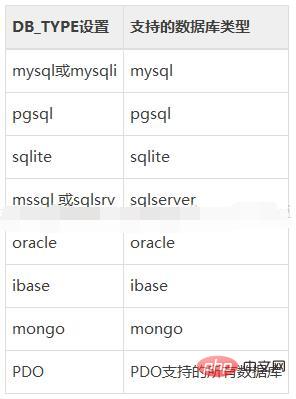
thinkphp can configure a new database separately. The setting method is: 1. Add configuration parameters such as "'DB_HOST' => 'localhost'..." in the application configuration file or module configuration file; 2. Define independent database configuration information in the configuration files of different application states; 3. Specify the database connection information when instantiating, with syntax such as "$User = M('User','other_','mysql://root ...".

The operating environment of this tutorial: Windows 7 system, ThinkPHP version 5, Dell G3 computer.
thinkphp can be used alone Configure a new database?
Yes.
Thinkphp model - connect to the database to configure the model database connection independently
Connect to the database
ThinkPHP has built-in abstraction The database access layer encapsulates different database operations. We only need to use the public Db class to operate without writing different codes and underlying implementations for different databases. The Db class will automatically call the corresponding database driver for processing. Currently The databases include Mysql, SqlServer, PgSQL, Sqlite, Oracle, Ibase, Mongo, and support for PDO.
If the application needs to use a database, the database connection information must be configured. The database configuration file has multiple definitions Method.
1. Global configuration definition
The commonly used configuration method is to add the following configuration parameters in the application configuration file or module configuration file:
//数据库配置信息'DB_TYPE' => 'mysql', // 数据库类型 'DB_HOST' => 'localhost', // 服务器地址 'DB_NAME' => 'thinkphp', // 数据库名 'DB_USER' => 'root', // 用户名 'DB_PWD' => '123456', // 密码 'DB_PORT' => 3306, // 端口 'DB_PREFIX' => 'think_', // 数据库表前缀 'DB_CHARSET'=> 'utf8', // 字符集
The type of database is given by DB_TYPE parameter settings.
The following are currently supported database settings:

If DB_TYPE uses the PDO type, the database type is determined by the DB_DSN configuration.
Or use the following configuration
'DB_DSN' => 'mysql://root:123456@localhost:3306/thinkphp#utf8'
Using DB_DSN mode definition can simplify the configuration parameters. The DSN parameter format is:
Database type://username:password@database address:database port /Database name#Character set
The character set setting needs to be valid in version 3.2.1 or above. If the character set is not set, the default is utf8.
If both configuration parameters exist at the same time, DB_DSN Configuration parameters take precedence.
Note: If you want to set up a distributed database, DB_DSN configuration is not supported for the time being.
If you use PDO driver, you must first configure **DB_TYPE** as pdo. Then you need to configure other parameters separately, for example:
//PDO连接方式 'DB_TYPE' => 'pdo', // 数据库类型 'DB_USER' => 'root', // 用户名 'DB_PWD' => '', // 密码 'DB_PREFIX' => 'think_', // 数据库表前缀 'DB_DSN' => 'mysql:host=localhost;dbname=thinkphp;charset=UTF-8'
Note: The DB_DSN configuration format of PDO mode is different, and the settings are different according to different database types. For details, please refer to the PHP manual.
The database connection information defined in the configuration file is generally used by the system by default, because generally the database access configuration of an application is the same. In this method, the system will automatically obtain it when connecting to the database, and there is no need to connect manually.
You can define different database connection information for each module. If the debugging mode is turned on, you can also define independent database configuration information in the configuration files of different application states.
2. Model class definition
If the connection attribute is defined in a model class, the defined database connection information will be used when instantiating the custom model instead of the configuration The default connection information set in the file is usually used for some data tables located in other databases outside the current database connection, for example:
//在模型里单独设置数据库连接信息
namespace Home\ Model;
use Think\ Model;
class UserModel extends Model{
protected $connection = array(
'db_type' => 'mysql',
'db_user' => 'root',
'db_pwd' => '1234',
'db_host' => 'localhost',
'db_port' => '3306',
'db_name' => 'thinkphp',
'db_charset' => 'utf8',
);
}It can also be defined in DSN mode, for example:
//在模型里单独设置数据库连接信息
namespace Home\ Model;
use Think\ Model;
class UserModel extends Model{
//或者使用DSN定义
protected $connection = 'mysql://root:1234@localhost:3306/thinkphp#utf8';
}
If we have configured additional database connection information in the configuration file, for example:
//数据库配置1 'DB_CONFIG1' => array( 'db_type' => 'mysql', 'db_user' => 'root', 'db_pwd' => '1234', 'db_host' => 'localhost', 'db_port' => '3306', 'db_name' => 'thinkphp', 'db_charset'=> 'utf8', ), //数据库配置2 'DB_CONFIG2' => 'mysql://root:1234@localhost:3306/thinkphp#utf8';
Then, we can change the attribute definition of the model class to:
//在模型里单独设置数据库连接信息
namespace Home\ Model;
use Think\ Model;
class UserModel extends Model{
//调用配置文件中的数据库配置1
protected $connection = 'DB_CONFIG1';
}
//在模型里单独设置数据库连接信息
namespace Home\ Model;
use Think\ Model;
class InfoModel extends Model{
//调用配置文件中的数据库配置1
protected $connection = 'DB_CONFIG2';
}3. Instantiation definition
In addition to specifying the database connection information when defining the model, we can also specify the database connection information when instantiating it. For example: if the M method is used to instantiate the model, also It can support passing in different database connection information, for example:
$User = M('User','other_','mysql://root:1234@localhost/demo#utf8');
means instantiating the User model, connecting to the other_user table of the demo database, and the connection information used is configured by the third parameter. If we have configured DB_CONFIG2 in the project configuration file, we can also use:
$User = M('User','other_','DB_CONFIG2');
It should be noted that ThinkPHP's database connection is lazy, so it does not connect to the database when instantiated, but The database will be connected only when there is actual data operation (in addition, when the system instantiates the model for the first time, it will automatically connect to the database to obtain the field information of the data table corresponding to the relevant model class).
Recommended learning: "thinkPHP Video Tutorial"
The above is the detailed content of Can thinkphp configure a new database separately?. For more information, please follow other related articles on the PHP Chinese website!
 Which one is easier, thinkphp or laravel?
Which one is easier, thinkphp or laravel?
 How is the performance of thinkphp?
How is the performance of thinkphp?
 The difference between python courses and c+ courses
The difference between python courses and c+ courses
 Usage of SetTimer function
Usage of SetTimer function
 Detailed explanation of quartz configuration file
Detailed explanation of quartz configuration file
 How to eliminate html code
How to eliminate html code
 How to use excel macros
How to use excel macros
 How to solve problems when parsing packages
How to solve problems when parsing packages




